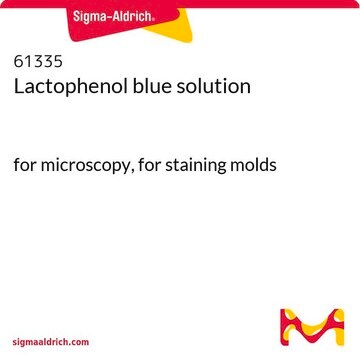18909
Calcofluor weiße Färbung
suitable for microbiology
About This Item
Empfohlene Produkte
Produktlinie
BioChemika
Qualitätsniveau
Form
liquid
Zusammensetzung
Calcofluor White M2R, 1 g/L
Evans blue, 0.5 g/L
Methode(n)
microbe id | staining: suitable
Farbe
blue to very dark blue
λmax
423-443 nm
Fluoreszenz
λex 423-443 nm in 0.1 M phosphate pH 7.0
Anwendung(en)
food and beverages
hematology
histology
microbiology
Lagertemp.
room temp
Eignung
fungi
parasites
yeasts
SMILES String
C1=CC=C(C=C1)NC2=NC(=NC(=N2)N(CCO)CCO)NC3=CC(=C(C=C3)C=CC4=C(C=C(C=C4)NC5=NC(=NC(=N5)NC6=CC=CC=C6)N(CCO)CCO)S(=O)(=O)O)S(=O)(=O)O
InChI
InChI=1S/C40H44N12O10S2/c53-21-17-51(18-22-54)39-47-35(41-29-7-3-1-4-8-29)45-37(49-39)43-31-15-13-27(33(25-31)63(57,58)59)11-12-28-14-16-32(26-34(28)64(60,61)62)44-38-46-36(42-30-9-5-2-6-10-30)48-40(50-38)52(19-23-55)20-24-56/h1-16,25-26,53-56H,17-24H2,(H,57,58,59)(H,60,61,62)(H2,41,43,45,47,49)(H2,42,44,46,48,50)/b12-11+
InChIKey
CNGYZEMWVAWWOB-VAWYXSNFSA-N
Allgemeine Beschreibung
Anwendung
Signalwort
Danger
H-Sätze
Gefahreneinstufungen
Carc. 1B - Eye Irrit. 2
Lagerklassenschlüssel
6.1C - Combustible acute toxic Cat.3 / toxic compounds or compounds which causing chronic effects
WGK
WGK 3
Flammpunkt (°F)
Not applicable
Flammpunkt (°C)
Not applicable
Persönliche Schutzausrüstung
Eyeshields, Gloves, type P3 (EN 143) respirator cartridges
Choose from one of the most recent versions:
Besitzen Sie dieses Produkt bereits?
In der Dokumentenbibliothek finden Sie die Dokumentation zu den Produkten, die Sie kürzlich erworben haben.
Kunden haben sich ebenfalls angesehen
Unser Team von Wissenschaftlern verfügt über Erfahrung in allen Forschungsbereichen einschließlich Life Science, Materialwissenschaften, chemischer Synthese, Chromatographie, Analytik und vielen mehr..
Setzen Sie sich mit dem technischen Dienst in Verbindung.











